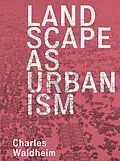A definitive intellectual history of landscape urbanism
It has become conventional to think of urbanism and landscape as opposing one another-or to think of landscape as merely providing temporary relief from urban life as shaped by buildings and infrastructure. But, driven in part by environmental concerns, landscape has recently emerged as a model and medium for the city, with some theorists arguing that landscape architects are the urbanists of our age. In Landscape as Urbanism, one of the field's pioneers presents a powerful case for rethinking the city through landscape.
Charles Waldheim traces the roots of landscape as a form of urbanism from its origins in the Renaissance through the twentieth century. Growing out of progressive architectural culture and populist environmentalism, the concept was further informed by the nineteenth-century invention of landscape architecture as a "new art" charged with reconciling the design of the industrial city with its ecological and social conditions. In the late twentieth and early twenty-first centuries, as urban planning shifted from design to social science, and as urban design committed to neotraditional models of town planning, landscape urbanism emerged to fill a void at the heart of the contemporary urban project.
Generously illustrated, Landscape as Urbanism examines works from around the world by designers ranging from Ludwig Hilberseimer, Andrea Branzi, and Frank Lloyd Wright to James Corner, Adriaan Geuze, and Michael Van Valkenburgh. The result is the definitive account of an emerging field that is likely to influence the design of cities for decades to come.
Autorentext
Charles Waldheim is the John E. Irving Professor of Landscape Architecture and director of the Office for Urbanization at Harvard University's Graduate School of Design. He is the author of Constructed Ground, the editor of The Landscape Urbanism Reader and Case: Lafayette Park Detroit, and the coeditor of Stalking Detroit and Composite Landscapes, among other books.
Zusammenfassung
A definitive intellectual history of landscape urbanismIt has become conventional to think of urbanism and landscape as opposing one another-or to think of landscape as merely providing temporary relief from urban life as shaped by buildings and infrastructure. But, driven in part by environmental concerns, landscape has recently emerged as a model and medium for the city, with some theorists arguing that landscape architects are the urbanists of our age. In Landscape as Urbanism, one of the field's pioneers presents a powerful case for rethinking the city through landscape.Charles Waldheim traces the roots of landscape as a form of urbanism from its origins in the Renaissance through the twentieth century. Growing out of progressive architectural culture and populist environmentalism, the concept was further informed by the nineteenth-century invention of landscape architecture as a "e;new art"e; charged with reconciling the design of the industrial city with its ecological and social conditions. In the late twentieth and early twenty-first centuries, as urban planning shifted from design to social science, and as urban design committed to neotraditional models of town planning, landscape urbanism emerged to fill a void at the heart of the contemporary urban project.Generously illustrated, Landscape as Urbanism examines works from around the world by designers ranging from Ludwig Hilberseimer, Andrea Branzi, and Frank Lloyd Wright to James Corner, Adriaan Geuze, and Michael Van Valkenburgh. The result is the definitive account of an emerging field that is likely to influence the design of cities for decades to come.
Inhalt
Preface vii
Acknowledgments viii
Introduction: From Figure to Field 2
One: Claiming Landscape as Urbanism 13
Two: Autonomy, Indeterminacy, Self-Organization 32
Three: Planning, Ecology, and the Emergence of Landscape 50
Four: Post-Fordist Economies and Logistics Landscape 69
Five: Urban Crisis and the Origins of Landscape 88
Six: Urban Order and Structural Change 107
Seven: Agrarian Urbanism and the Aerial Subject 124
Eight: Aerial Representation and Airport Landscape 140
Nine: Claiming Landscape as Architecture 160
Conclusion: From Landscape to Ecology 177
Notes 185
Index 197
Credits 204
